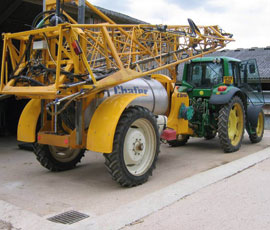Are biobeds the answer to dealing with sprayer washings?

Spill concentrated pesticide on the ground or wash down a sprayer so that the washings are not retained and there could be big problems both for the farmer and for the wildlife on the receiving end – not to mention the waterways that feed into reservoirs or boreholes.
But accidents can and do happen, so it follows that precautions need to be in place to prevent the spillage of pesticide becoming a major issue.
This will normally take the form of a bunded concrete pad on which the sprayer can stand while it is being filled or washed.
The area has a fall to ensure that all spillages, leaks and washings are channelled into a catchment area from which they can be retrieved for chemical disposal or, as is increasingly popular, passed through a biobed or a biofilter.
Direct or indirect?
Before considering how big a biobed should be, you need to differentiate between direct and indirect biobeds. Direct versions allow the sprayer to drive over and park on the biobed for washing – this requires grilles supported on cross beams.
Indirect versions involve driving the sprayer over a concrete bunded area, with the washings held in a temporary tank before being sent to the biobed.
The maximum amount of pesticide washings allowed for a single biobed is 15,000 litres in any 12-month period, so an indirect biobed receiving 650mm of rain each year needs to be able to process a total of 37,750 litres.
With 1cu m equalling 1,000 litres, a surface area of 38sq m and 1m deep is required. More realistically, that will involve an area 6×6.5m and 1m deep.
“Rather than making a hole in the base of the liner for the clean water to run out into a pipe after it has passed through the organic material, it is easier and safer to place a large-bore pipe in a sump in the middle of the lined tank with small holes in its base to allow the water to percolate in. It can then be pumped out,” explains farm consultant Bill Basford.
Biomix
And now for the biomix – the organic material that is going to do all the work. This is made up from a mixture of (by volume) two parts straw, one part compost – preferably peat free – and one part soil.
“If possible, the mix should be left to stand for a couple of months to enable the composting process to start to break down the straw and create a more homogenous mix,” he says.
Once in place and covered with turf, the process can be started. The liquid from the temporary storage needs to be distributed evenly over the biobed so that the full surface area is used.
This can be achieved via a drip irrigation system, which can work at low pressure. Use a small 50-litre/min submersible pump working with a float switch or, if the terrain allows, do it by gravity, assuming there is about 7m of head pressure.
Where a pump is required and there is no accessible mains electricity supply, it is possible to use a battery power supply charged by a small solar panel.
But how about a biofilter?
“At a cost of well under £1,000, a biofilter is even less expensive than a biobed yet it would appear to be capable of a similar job,” suggests Mr Basford.
“Rather than an excavated bed it uses 1,000-litre capacity intermediate bulk containers [IBCs] to hold the biomix through which the washings are passed.”
As many as three IBCs, each with their lids cut off, are stacked on top of each other, with the liquid from the temporary store pumped up to the top one and distributed evenly across its surface.
As it exits at the bottom it is redistributed across the second IBC – and so on until it leaves the bottom one as “clean” water.
“If three IBCs are used – and two may be sufficient in some circumstances – there clearly needs to be some means of support to prevent them falling over,” he says.

